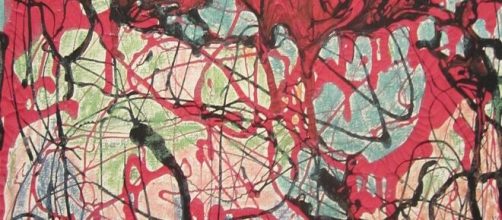The age-old bias against female artists advanced into the 20th-century when art historians like Karl Scheffler penned an article in 1900 titled “Architects in Skirt.”
He said that women have no place in the field, characterizing the prototypical architect as “a rugged workman who creates in the wind and weather of the building site.” You know, like Gary Cooper playing Howard Roark in the movie "The Fountainhead."
Forgotten female
JTOR, a digital library that boasts publishing articles grounded in peer-reviewed research, published Scheffler’s “Architects in Skirts,” naming him “the influential architectural theorist of his day.”
With his way of thinking and his peer’s acceptance, it’s no wonder that women practicing any art form are overlooked.
Lee Krasner, who worked in the shadow of her husband Jackson Pollock, comes to mind. The art world has been a long-running man’s world.
Movie boner
Pollock is on my mind given an ArtMoney report that describes the painter Janet Sobel as “the forgotten female artist who influenced Jackson.” Influenced is not the best word to describe the sway her work held over his. He actually got the idea for his “drip painting” from her. So much for Ed Harris's portrayal in the biopic “Pollock” conceiving the drip painting technique in his studio by accident.
ArtMoney points to Sobel’s Milky Way dripped in 1945, and Pollock’s Blue Poles dripped in 1952, calling them “incredibly similar in both composition and technique.” Yet, her innovation was never heralded unless you count art critic Clement Greenberg, a fan of Pollock, who tagged Sobel’s efforts “primitive.”
Art patron Peggy Guggenheim included Sobel’s drip painting in her “The Art of This Century” gallery in 1945.
On seeing her work, Pollock allowed that it “made an impression on him.” But it was more than that. Sobel’s work made him famous and has left her relatively an unknown even despite ArtMoney naming her “the true creator of the “drip painting’ technique.”
Pollock’s Plunder
The New York Times reported that Guggenheim gave Sobel a solo show at her gallery in 1946, calling her “the best woman painter.” That’s the exhibit where critic Greenberg saw her drip painting and called it “primitive.” The report makes plain that “Milky Way” was made a year before Pollock’s first drip painting (titled “Free Form”).
Greenberg’s opinion mattered, and Sobel died in 1968 without so much as a nod to her contribution to Pollock.
Clearly, this is a thing. Daily Art Magazine has drawn up a list of other innovative female artists forgotten or marginalized by history, who are now taking their rightful place on museum walls. Consider the mid-16th-century painter Caternia van Hemessen, recognized today as the first painter to make self-portraits at her easel.
Like Sobel, she’s one of those artists now credited for inventing a genre.
Wait, there’s another “first.” In the early 20th century, Hilma Af Klint painted abstractions ahead of Wassily Kandinsky, who is mistakenly credited as a pioneer of abstract art. Art history books need a major re-write, don’t you think?


